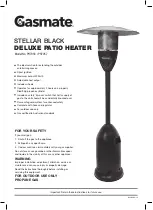
12
Charging the System:
Once the components are plumbed you are ready
to charge the collector loop. This is done at the
Drainback tank on the tank system assembly. It is
recommended that the collector loop be flushed to
insure all solder fluxes and any other contaminants
are not present when the final distilled water charge
is put in. A pre-charge of regular tap water can be
run through the collector loop for several minutes
prior to the final operating charge being installed. If
there is evidence of sever contamination in the
piping, tri-sodium phosphate(TSP) can be added to
the tap water charge.
If a pre-flush is determined to be needed the
Drainback Tank should be filled with regular tap
water to the FILL Line on the side of the tank. At
this point ¼ to ½ cup of TSP can be added if
necessary. When ready, plug in the controller. The
pump should be turned on and off several times at
5 minute intervals to flush the system piping. The
pump can be turned off and on with the manual
switch located inside the controller front panel.
When this is completed drain the solar loop using
the System Drain Valve below the pump (On DBSA
systems the System Drain Valve is behind the
shroud). When the tank is fully drained use a hose
to continue flushing out the drainback tank for 5
minutes. Turn off the hose and let the system drain
fully. Make sure the controller is set back to the
automatic position. Unplug the controller when
finished.
After flushing and the drainback tank is completely
drained, fill the drainback tank to the Fill Line on the
side of the tank with pure clean distilled water. If the
election is made to add a gallon of propylene glycol
to the system, leave room for this when filling the
tank.
Use of inhibited propylene glycol, plain
water or a concentration of these two fluids as
the Heat Transfer Fluid (HTF) in this system is
strictly prohibited.
If propylene glycol is added to the solar loop a
method of checking the heat transfer fluid for PH
must be implemented. See “Service” and “System
Parts List” Sections in this manual for instruction.
12
Flat plate collectors can reach temperatures over 300
0
F
under the right conditions. Always be cautious when
working around flat plates that are exposed to sun
light. Water passing through tube incorporated in the
plate picks up heat to transfer to the water heater.
This completes the system installation procedure.
OPERATING INSTRUCTIONS
Refer to Figures 1 and 2 or the system schematics
at the end of this manual for references in operating
this system.
System Start Up:
Drainback type systems are the simplest of the
active type systems to start up. At this point all that
remains is for the controller to be plugged into an
outlet. A red light (First one on the left) on the front
of the controller should indicate power is present. If
not check to see power is present at the outlet.
If sufficient solar energy is present the system will
begin to operate automatically. When the collector
is hotter than the tank by 12
0
F or more the Number
One light (Center one) on the controller will come
on indicating that power is supplied to the pump.
Water is lifted by the pump to the collector where it
picks up heat and is returned to the drainback tank.
The drainback tank supplies the water to the heat
exchanger where it gives up heat energy to the
water heater tank and is then sent back to the
collector by the pump. This cycle continues as long
as the collector is hotter than the tank. In “DB” type
systems the heat exchanger is wrapped around the
steel water heater tank so heat energy is
transferred by conduction through the tank wall to
the water. In “DBSA” type systems the solar heated
fluid is sent to a “Side Arm” heat exchanger located
out side the tank jacket. In this type heat exchanger
the solar heat fluid passes around the outside of a
bundle of vertical tubes that have the potable water
inside them. The heat causes the potable water to
rise where it moves back into the main tank. When
this happens, cold water flows in from the bottom
where it is heated. This is called a thermo-syphon
cycle and it will continue was long as long as heat
is available from the collectors.
With the pump running, check all lines, fittings and
joints for leaks. If leaks are present, unplug the
controller, wait for the HTF to drain back and then
make repairs. To start up again, plug in the
controller.



































